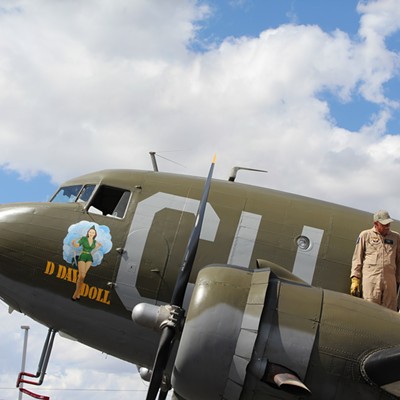Today, Danny Morales turns away from that view, as a hot breeze kicks up around the venerable tower. President of Morales Restoration and Builders, he's the third generation of his Tucson family to help repair the old mission; his grandfather, Apolino, first put his trowel to the church in the 1940s. Now his father, Sonny, is re-plastering an elegant cornice at the tower's base, some 80 feet below.
In turn, the Morales crew consists of several Tohono O'odham craftsmen who have even deeper ties to this place, considering that their ancestors helped build San Xavier in the late 18th century.
Together, this crew is giving the west bell tower a thorough overhaul. Working here, says Morales, is something of a religious experience. "There's no structure like this in the United States that's still standing," he says. "This tower has survived tornadoes, survived earthquakes, a lot monsoon storms."
In recent years, the lovely mission has also emerged from a $1.5 million, painstaking restoration of its richly ornate interior, a project spanning several years and drawing top restoration experts from around the globe. As a result, hushed walls are again awash in brilliant colors; stately statues of the 12 apostles and a serene Virgin Mary are flanked by majestic columns and intricate murals. In the main dome, a brown-robed San Francisco de Asis receives the stigmata, his bloody hand a riveting red, his face a study in serenity. The sanctuary is a stunning mélange of rustic and ornate retablos painted in Prussian blue and vermilion.
Now it's the tower's turn. But cash has become a problem; The Patronato San Xavier, a group founded in 1978 to raise funds for the mission's restoration, is in a pinch. On the other side of the tower stands Bernard Fontana, a retired UA anthropologist, Patronato-co-founder and head mission cheerleader, who probably knows more about this church's long history than any man on Earth. He says keeping the funds flowing has become a challenge. Though the Patronato has an endowment--currently at $865,000--more is always needed to keep history from repeating itself.
"The history," Fontana says, "has been to start campaigns to work on (San Xavier). People would spend a lot of money and (put out) a lot of effort. Then they'd walk away saying, 'Well, we're all done.' And 30 years later, it's a big mess. We want to keep that from happening again.
"We're going to make it through the summer," says Fontana. "But one of the reasons for the endowment is because (San Xavier) will forever need to be checked, for lime to be replenished, for small cracks to be taken care of before they get to be big cracks. Hopefully, never again will this place have to be stripped down."
It's not like Tucson has any choice: The mission is as much a part of our collective consciousness as the desert and the mountains. Like other Southwest missions, San Xavier tells of tumultuous times and sweeping change as colonial Spain gained a foothold here. Even the architecture cleverly blends old and new worlds: flat-roofed, rectangular structures sweep forward into graceful belfries; vigas--interior beams rooted in Islamic and Gothic styles--support ceilings of saguaro ribs, mud and straw.
Father Eusebio Francisco Kino, the legendary Jesuit, first visited Tohono O'odham villagers near present-day San Xavier in 1692. Soon, he'd convinced them to build a church. Besides his notable charisma, the savvy priest boasted another bargaining chip: cattle. The luxury of domestic livestock finally won the Indians over, suggests Fontana. "Either way, it's clear that when the O'odham were helping to building San Xavier, they were not doing so at the point of a gun," he says
Spain eventually ordered Kino's Jesuits to leave the New World; Franciscans took over and built San Xavier. Maintaining the mission has been a labor of love ever since. Just ask Danny Morales, who is now climbing down a complex web of metal scaffolding to the ground. "My grandfather actually started here," Danny says, "sometime in the 1940s."
But he can't remember exactly what it was that his grandfather did. "Hey, Pop," says Danny, "in the '40s, what did Grandpa do here?"
Sonny Morales, Danny's dad, turns away from where he's plastering a cornice at the tower's base. "It was 1947," he says. "They did some work in front." Sonny himself did brickwork on the mission school. "I first came here in '56," Sonny says, before turning back to the cornice.
Now, like the Patronato's fundraising, Danny Morales and crew face a new set of hurdles. "One was just trying to figure out how to work on the project," Morales says. "We built this whole scaffold, and that was a challenge in itself."
Another chore was fixing all the "repairs" done in the past. The workers "had to remove 20 tons of concrete, just from this tower," says Fontana. "Every time something cracked or broke loose in the past, people would just throw some more cement on it".
Today's repair work is done with lime--the mission's original plastering material--laced with boiled-down prickly pear juice to help it cure. "The lime literally allows the building to breathe," says Fontana. "We're back to where they were 200 years ago, which turns out to be the best."
Back in the tower, the breeze has dropped a bit as Danny Morales brushes his fingers across an ancient brick, which quickly turns to powder. "We have to go through every joint, every brick, every crack, inside and outside," he says. But he doesn't mind. "We used to be on a project six months or a year, and I'd get sick of it," he says. "You don't get that here."
Morales pauses. "Time is different up here," he says. "It's different than time in town, or time somewhere else. It's hard to explain." Then he turns his gaze back to the world far below, where a dust devil rises like a ghost from the hot desert floor.










